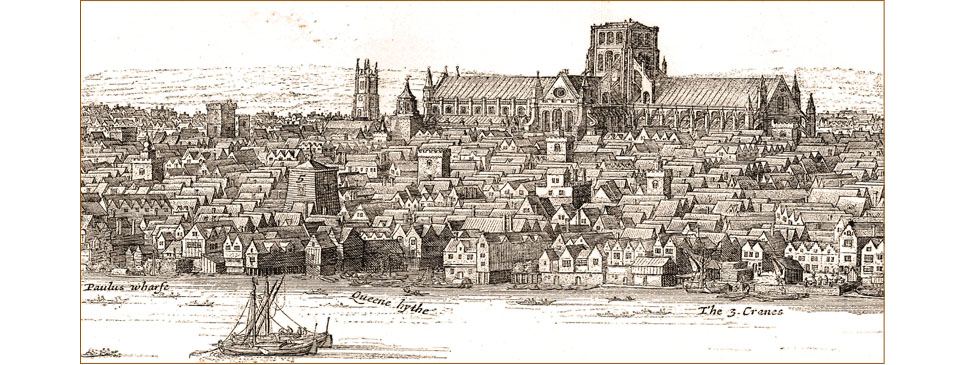St. Paul’s Cathedral during the reign of Elizabeth I

St. Paul’s seen from the Thames in this detail from Wenceslaus Hollar’s panorama of London. It shows the cathedral after the destruction of the medieval spire by a lightning strike in June 1561. Despite being etched by Hollar in 1647 it appears to omit Inigo Jones’s west portico, built in the 1630s.
The Tudor period, during the reigns of Henry VIII, Edward VI, Queen Mary, and Queen Elizabeth, was one of great convulsions in religious worship, known as the Reformation. England lurched from Catholic to Protestant, briefly back to Catholic during the reign of Queen Mary, and finally returning to Protestant under Queen Elizabeth. St. Paul’s Cathedral in London was at the centre of these great changes.
Queen Mary died in November 1558 but little changed at St. Paul’s until well into the following year. Edmund Grindal, a Protestant, had previously been nominated as Bishop of London under Edward VI, but Mary’s succession forced him into exile. He returned to England in January 1559 on the day of Elizabeth’s coronation, and in May of that year at Paul’s Cross, the pulpit in the cathedral’s churchyard, announced the restoration of ‘King Edward’s Prayer Book’. Two weeks later the Catholic Edmund Bonner was deprived as Bishop of London after he refused to take the Oath of Supremacy and was succeeded by Grindal. William May was restored as Dean of St. Paul’s, with his predecessor Henry Cole imprisoned in the Tower, eventually dying in Fleet Prison. Some items of Catholic worship were stripped from London’s parish churches and in August 1559 burnt in the cathedral precinct.
The cathedral’s mighty steeple had dominated the skyline of London for centuries and provided a landmark for ships navigating the river. In June 1561 it was struck by lightning during a violent storm and the steeple destroyed by the subsequent fire. (The steeple of the nearby church of St. Martin’s Ludgate was also destroyed during the same storm). The bells that hung in the steeple came crashing down to the floor below. It proved impossible to raise enough funds to replace the steeple but £6,000 was forthcoming by means of a tax on Londoners, from clergy of the diocese, and gifts from Queen Elizabeth and others. The Queen also supplied timber and the remaining square tower was re-roofed. It remained a stump until the old cathedral was rebuilt in the 17th century after the Great Fire of London.
In May 1570 a papal bull from Pope Pius V was fixed to the door of the Bishop’s palace at St.Paul’s during the night. In a country still divided over the question of religious worship it was a serious matter. Its intent was to excommunicate Queen Elizabeth, to relieve her subjects of their allegiance, and to induce Catholics to rise up against the Protestant government. The homes of London’s known Catholics were searched and a second copy of the bull was found in the home of William Mellowes at Lincoln’s Inn. Under torture on the rack he gave the name of John Felton as the person who fixed the bull to the door. On the rack Felton also implicated the Spanish Ambassador in the plot before being hanged, then quartered alive in St. Paul’s churchyard.
In August 1588 Londoners learnt of the failure of the Spanish Armada when Dean Nowell preached a sermon of thanksgiving at Paul’s Cross, just as the enemy fleet were still attempting to navigate back to Spain around the north of Scotland. That November large crowds gathered for Elizabeth’s only visit to the cathedral.
The Reformation generally reduced the importance and necessity of cathedrals. In the following decades St. Paul’s descended somewhat into a market, selling food and ale, inhabited by all-comers including businessmen doing deals, and becoming a hang-out for thieves, tricksters, beggars and prostitutes. Clergymen advertised their services. Parts of the building and cloisters were leased out to carpenters, trunk-makers and glaziers. The nave became a public throughway and a shortcut between Carter Lane and Paternoster Row, even during services. Smoke from sheds that had been erected in the churchyard was polluting the inside space and windows were broken by schoolchildren’s games, with sections left unglazed. The steeple-less tower was used by tourists to gaze across the city, whooping as they dropped stones down the side. Rubbish remained where it was left, and drunks slept in the stalls. The discipline of cathedral clergymen had declined, disrupting the daily order of services.
During the late 16th century a division was taking place in Protestant theology. Reforms had created Anglicanism, but there were Calvinists – followers of the teachings of John Calvin – who believed that changes should go much further, eliminating details of the service they saw as idolatrous. As reaction against that, there was already an anti-Calvinist movement taking place among the clergy of St. Paul’s who argued for more ceremonialism, which they believed to show greater reverence. It was a debate that would split the country during the 17th century, culminating in the Civil War and the temporary overthrow of the monarchy.
Sources include: Various – St. Paul’s – The Cathedral Church of London; Liza Picard ‘Elizabeth’s London’. Illustration courtesy of the collection of Hawk Norton.
< Back to St. Paul’s during the Reformation
Forward to The rebuilding of St. Paul’s Cathedral after the Great Fire >


